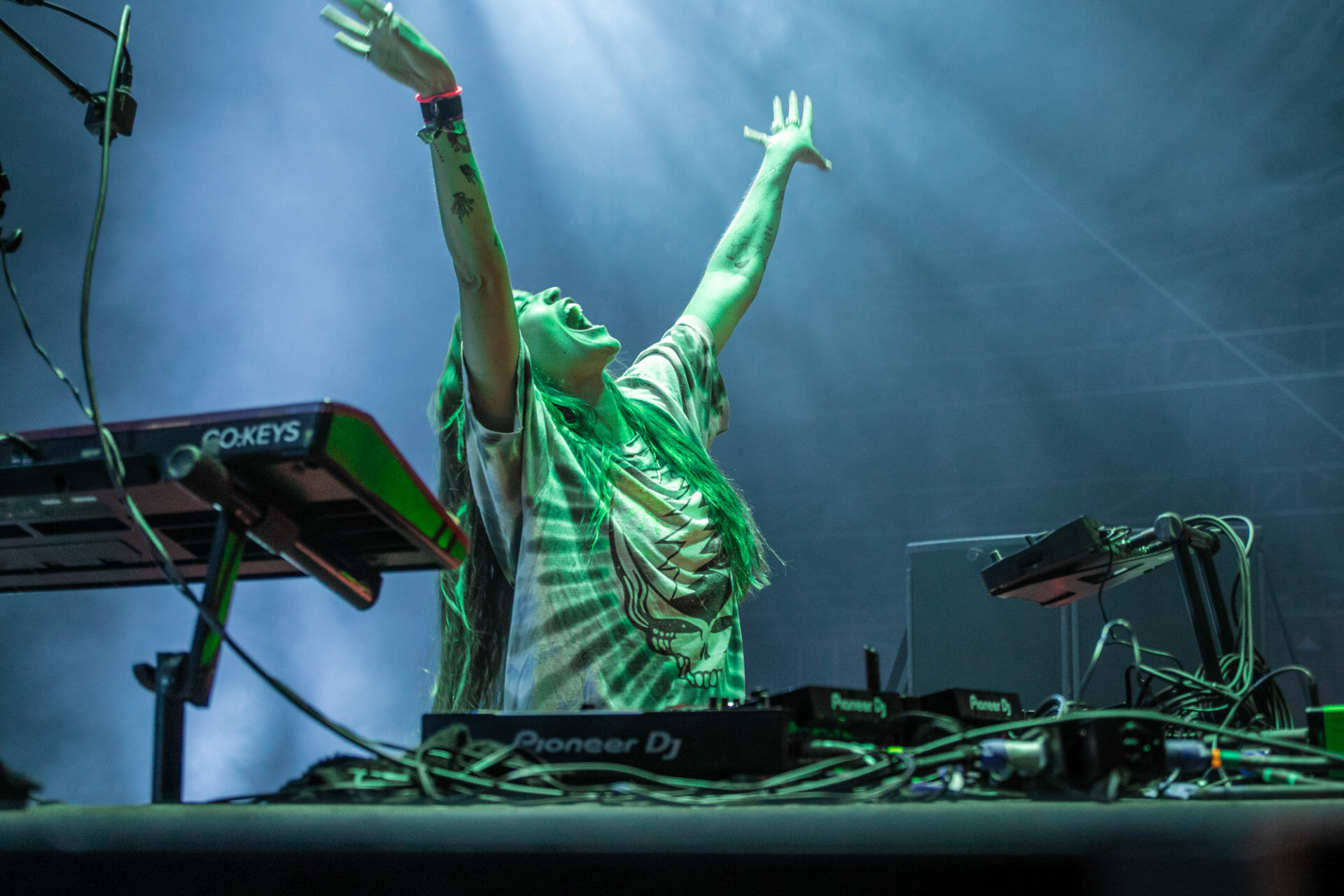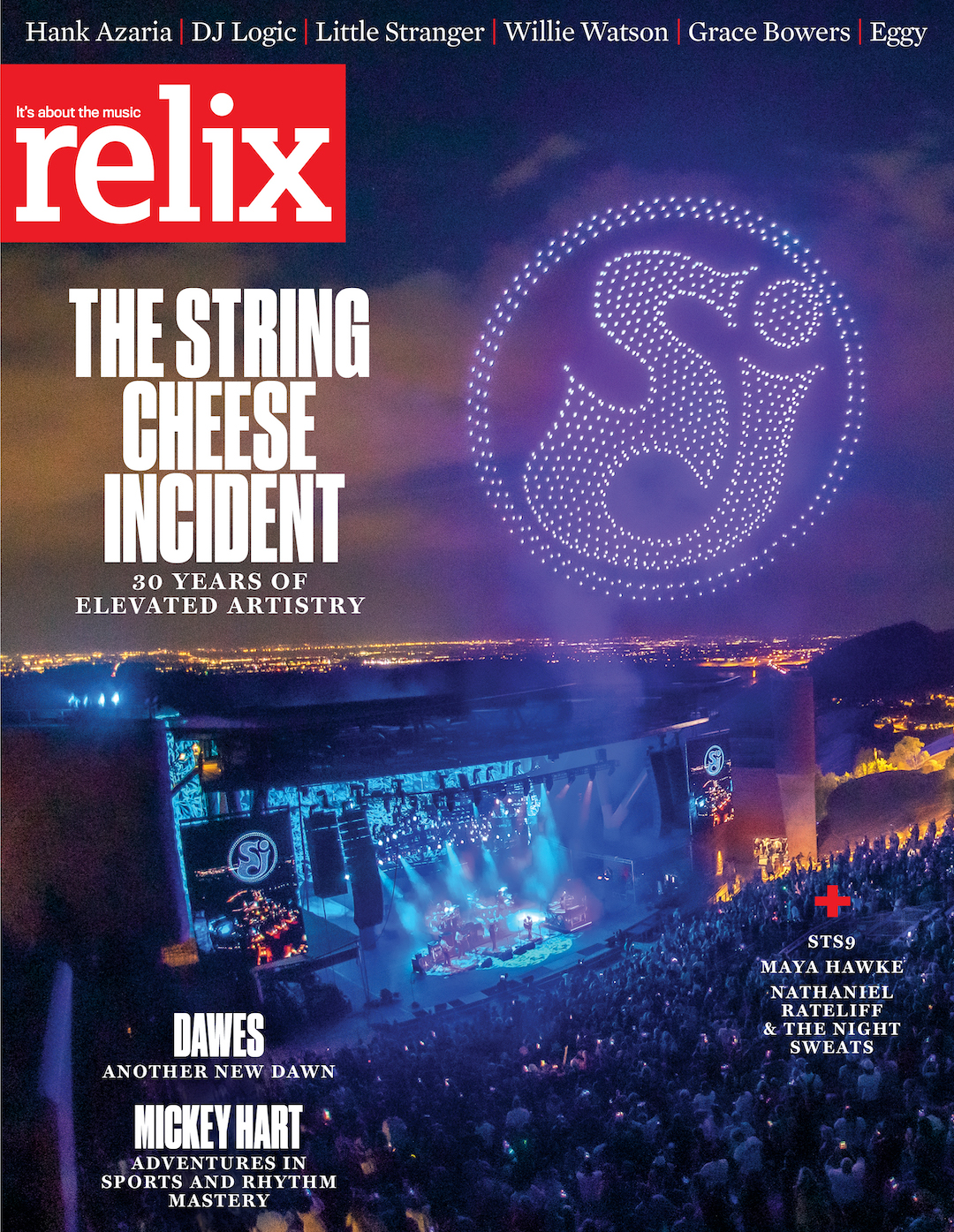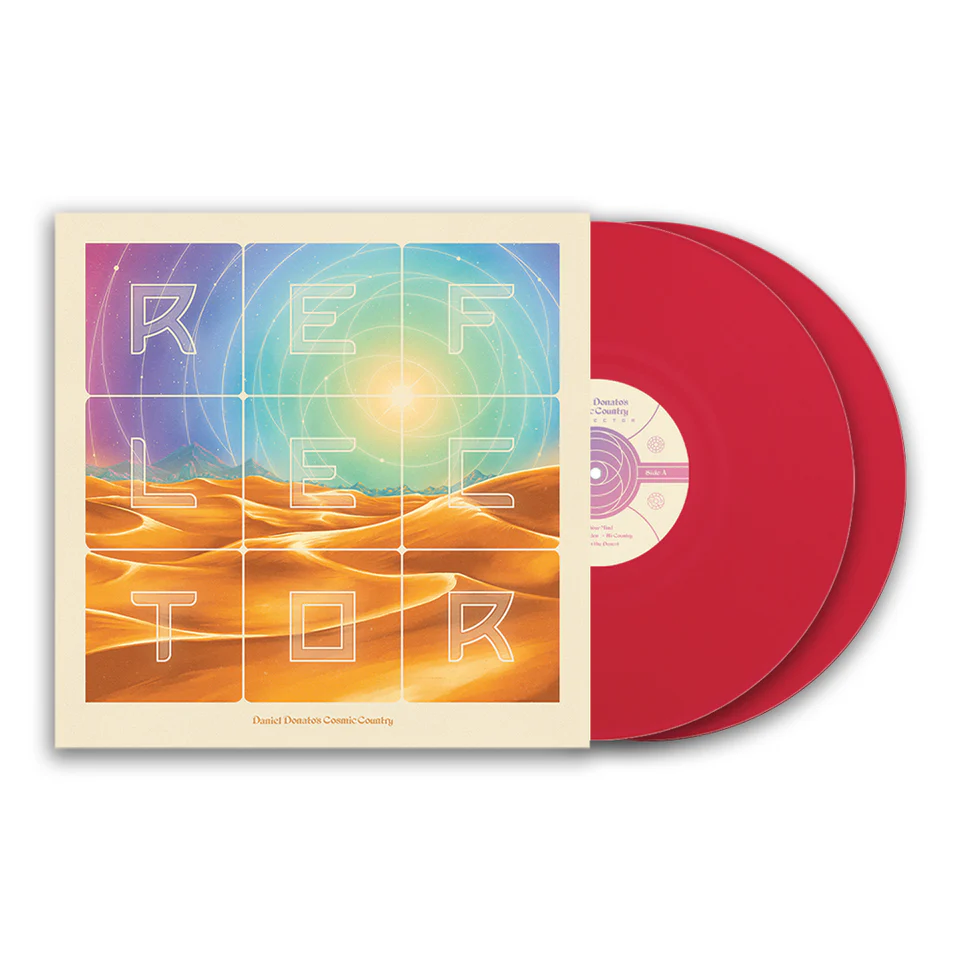LP Giobbi Remixes Jerry Garcia: “I Wanted to Show This Beautiful World to My Community”

“When I began working on this project and I started listening to Jerry’s isolated voice, it really felt like I was listening to a family member,” LP Giobbi says of her work on the new Garcia (Remixed) release, which celebrates the 50th anniversary of Jerry Garcia’s debut record by reimagining it in a new environment.
LP Giobbi has toured the globe over the past few years, earning plaudits as a DJ, producer, entrepreneur and co-founder of the nonprofit organization Femme House, which addresses the lack of equity for women in electronic music. However, she has never strayed far from her Eugene, Ore. upbringing, where she grew up as Leah Chisholm.
“My parents were Deadheads,” she acknowledges, “so Jerry’s music was always on in our house. He’s the background of my childhood. I’ll never forget the day he died—it was like a family member died. So working on this was such an awesome, intense process.”
LP Giobbi was a piano prodigy and self-described “band geek” who attended college at UC Berkeley, graduating in 2009 with a degree in jazz piano performance. She wasn’t sure what might follow, until her final semester of school when she read Bill Graham Presents.
“Being raised by Deadheads, that book really spoke to me,” she says, “but I didn’t even know about the promoting side of the music industry growing up. Then I found out that Greg Perloff, who took over Bill’s company after he died, later left and started Another Planet Entertainment, which was right down the street from my apartment.”
She started interning for APE and then spent four years working for the company, before another moment of serendipity led her to LA and, eventually, onto stages at Coachella, EDC, Firefly, Lollapalooza, ACL and numerous international settings.
Through it all, she maintained her affection for the Grateful Dead, which eventually resulted in an offer to perform a special set at 2022’s Playing in the Sand. “It combined the Dead with house music, so I called it Dead House, which is pretty simple and straightforward,” she says with a laugh. After that event’s last-minute cancellation, she found a receptive new audience via The Relix Channel on Twitch.
The opportunity to reconceptualize Jerry Garcia’s first record soon followed.
Looking ahead, LP Giobbi reveals, “I will be doing two Dead House sets at Playing in the Sand in 2023, and there will be more to come. I’m doing quite a few of them next year, and I’m really excited about it.”
After Berkeley, you worked at Another Planet and picked up jazz gigs. How did you find your way into the DJ and dance community?
I was playing one at night at this bar down the street from the Independent called the Madrone Art Bar. A producer/engineer for Daft Punk walked into the bar, approached me during my 15-minute break and asked if I would be interested in joining this all-female electronic band in LA.
At the time, I didn’t know how to turn on a synthesizer. I knew nothing about electronic music and I barely knew who Daft Punk was. I told him: “I don’t really know anything about electronic music.” And he said, “No, the band is made up of jazz musicians. You’ll learn electronic instrumentation together and it will be super easy for you.”
I called my parents, and my dad was like, “You don’t have golden handcuffs right now. You don’t have kids to support. So maybe just leap.”
I went down there thinking it would be easy. Luckily, I thought that or else I never would’ve done it because it was a huge learning curve for me. I was the synth player in this band learning synthesis and sound design. We did everything live and it did not come naturally to me.
Then I was in the studio one day and I was reading an article about Grimes, who was talking about how she produced her own records. This huge light bulb went off for me because it had never even occurred to me that I could have that role. I started doing some research and realized that only 2% of producers are women. Luckily the band let me start producing, so I learned by trial and error.
I became obsessed with providing visual representation for other people. It’s something I’ve continued at Femme House. Not that I think more female producers will change the world, but when you see yourself in as many roles as possible and you think you can do anything, then you can do anything. That does change the world.
Did your years of jazz instruction, where there can be a penchant for over-intellectualization, complicate your transition into the dance realm?
I remember going to see my first DJ show, and I was so confused. I was like, “Where is the music coming from? Where’s the band? There’s only one guy up there. How is there so much sound?” I didn’t understand the idea of a WAV file in a USB stick. [Laughs.]
Some people refer to dance music as body music, and I quickly came to appreciate that while I was standing there. I had spent the last four years of my life in college intellectualizing everything. Obviously, jazz is a feeling, but as somebody who studied in school, I know exactly what note can go over what chord structures and it became very much in my head. So all of a sudden, I had to drop into my body and figure out a way to use the least amount of notes while still feeling groovy.
So how can you intellectually de-intellectualize it? When I first started making electronic music, Sofi Tukker became a big mentor of mine. I would send my demos to them, and they’d be like, “There are way too many notes in this. You’re trying so hard to say so many things that it doesn’t actually end up feeling good.”
During the pandemic, I felt it was inappropriate to be making banging electronic music when there was weren’t any dance floors. By that point, though, I felt like I was at a skill level where I understood how to groove. I was ready to bring back in a seventh chord and a diminished chord to see if I could make that feel good. So I had to learn everything, break everything back down, and then slowly learn it again.
You’re both a producer and a DJ. When you’re in the latter role, to what extent do you draw on your own music?
The skill of DJing is a totally different skill set than producing. But the way that I make a living as a producer is that I go on tour as a DJ. So I have to spend 50% of my time honing the craft of DJing and crate digging and making edits and sequencing things and learning how to loop different things together. The skill of producing is totally different.
As a producer, what informs the music I make is that I usually start by thinking, “OK, I want to make a track that I would I play at peak hour—five in the morning—in Ibiza. What would that be?” And it might be at a particular party at Pacha versus a different nightclub.
I’ll imagine the environment and make a track for that moment. That’s how my crates are organized on my hard drive when I’m DJing. So it’s completely dependent on the dance floor and the environment and many other factors.
I think it’s your job as a DJ to get your audience in, get them to trust you and then push them a little bit. Sometimes your music just isn’t appropriate for the setting. There are so many different factors. Where in the world are you? Who’s playing before you? Who’s playing after you? What time of day is it?
So some sets, I won’t play a single one of my tracks because that’s not what the dance floor is calling for. And some sets, I will play only my music because that’s what the dance floor is calling for.
You can prep for a set but you just never know what you’re going to end up playing. In that way, I think it parallels the Grateful Dead. Most DJs don’t play an instrument, however, there’s a through line in having to be improvisational.
While most DJs don’t play an instrument, you do play a keyboard up there. Do you take a similar improvisatory approach with it?
I have three decks, a sampler and a keyboard. It’s with me at every set and there are some sets where I play it very little, some sets where I’m playing it nonstop. Again, it just sort of depends on the environment I’m in.
What’s so cool is that all my songs are organized by key. I know this song is in C minor, so I can do a little progression in C minor on the piano, record it into the sequencer, chop it up differently, sequence it differently and have it playing over a different track. That makes the process super fun. Sometimes it sounds like shit and sometimes it sounds good. You never know.
You grew up in a Deadhead household. At what point did you begin to make connections between that community and the dance community?
I became a female producer and then I went through this very weird, intense thing where I wanted to be taken seriously in my industry—in the specific world of electronic dance music. There are so few female DJs and producers, and I only wanted it to be about my music. So I wanted to wear something that would stand out but didn’t feel too feminine, which was an unfortunate response to the society that I was in.
At the same time, my parents gave me a bunch of vintage Grateful Dead T-shirts. So I was like, “Great! I don’t want to think about what I’m going to wear anymore. I’m just going to wear these when I tour.”
So I started wearing these Grateful Dead shirts and I soon came to find out that there are quite a few dance Deadhead fans. I started getting DMs from Deadheads who were at my shows and were like, “Whoa, you listen to the Grateful Dead?”
Then a friend of mine, who had seen me playing in a Grateful Dead shirt, told me, “I was in a studio recently and I ended up getting some stems for the Grateful Dead. I can send them to you, just don’t do anything bad with them.” I was like, “I would absolutely love to hear Jerry’s voice!” So I got five or six tracks and, for a while, they just sat on my hard drive.
Then during the pandemic, I was livestreaming on Twitch every single day. I started to build an audience and I really wanted to make a unique show every time. So I ended up getting a sampler, playing different piano licks and sequencing them. Then I realized, “Oh, I can put in my own samples here.”
That’s when I started going through my hard drive of stems and songs and saw those Dead songs again. I thought, “This could be really fun to play with.” I would loop drums in one CDJ and I started playing with the guitars and the vocals.
One year before the pandemic, I took my parents to a rave and my dad stepped onto the field and he was like, “Oh, I get it. If I was born now, I’d be a raver instead of a Deadhead. I’d be taking molly instead of acid. But pretty much everything else is the same.” There are a lot of similarities with the peace/ love/unity/respect culture— the PLUR culture in the dance community. I really started seeing it through that lens.
How did you wind up remixing Garcia?
I was asked to do a livestream for this really cool nonprofit called Backline that supports the mental health of touring artists. Bob Weir also was doing the same livestream. His manager saw what I was doing and reached out to let me know that he thought I was doing something cool. I was really blown away and freaked out.
At the same time, my agents knew that I was a Deadhead kid and starting to develop a whole new foundation of love and respect for this community. So through all of that, I was booked for Playing in the Sand in 2022.
I spent a few months working my ass off on the set because my parents were going to be there and it would be such a huge moment for my family. I started making my own Grateful Dead edits with these stems—not to release, but just to play in a set. I was making as many different licks with the guitar parts as I could, repitching the vocals to fit over different songs and putting the two worlds together, as best I could.
Then it got canceled. I had just played a gig and the day I was traveling there it was canceled. My parents were sobbing, I was sobbing.
But I decided I had already done so much work for these sets, I wanted to livestream them. I started working with Ben Baruch, who suggested that I stream on Relix, which is how I found even more of this beautiful community.
Then Ben ended up connecting me with Marc Allan at Red Light, who works with Trixie Garcia on the Garcia Estate. Marc was like, “It’s going be the 50th anniversary of Garcia, and we’re going to rerelease the vinyl. Would you be interested in remixing some of the tracks?” That was the craziest day of my life. I told him that, of course, I would. Then I said, “I’m sorry, can I call you right back?” So I immediately hung up and called my parents. They were like, “Shut up!” [Laughs.]
As you began the project, did you have an overarching musical theme that informed your work or did you approach it on a more granular level, track by track?
When I originally asked what songs I could do, they told me: “Whatever you want.” At first, it was way too overwhelming to think about the whole thing, so I just took it one track at a time.
Some of the songs are in 3/4 and they’re 75 bpm—and all dance music is in 4/4 around 125 bpm—so I didn’t even know if I was going to be able to do anything with those. I had to go a little bit far in order to make DJable tracks for a few of the songs. In those cases, I was like, “Let me take as few parts as I can” because I still wanted it to be identifiable to this community. Those were really about me paring things back once again. But some other songs were already 125 bpm and in 4/4, so I was like, “Yes, Jerry!” [Laughs.] Those just flew and flowed really easily.
At that point, my tour schedule got absolutely insane. So as I was flying around the world, I was renting studios where I could try to finish this album. It was so much work and I put so much pressure on myself because I wanted it to be the best thing I’ve ever done.
Can you talk about the process of striking a balance between honoring the original music and creating something new?
I want it to be so clear that these songs cannot be made better. That’s not what a remix is; it’s just a reimagining. When I think of Jerry, I think of his voice and his guitar, so every song had to have that. I had to figure out a way to get parts of those things and stay as true to the original sound and bpm and pitch as possible.
When I was creating these tracks, I was creating them to pay homage to and respect to my childhood. I also wanted to show this beautiful world to my community that might not know the Dead.
The craziest thing is that at my shows, my fans now wear Grateful Dead shirts and most of them have no idea who the Dead are. I’ve come out after a show, started talking to fans wearing them and asked, “Are you a Deadhead?” I’ve often heard, “No, I’ve actually never listened to the band. But this is what you wear.”
Everybody’s entry point to the Grateful Dead is different and I thought it would be exciting to share this with them.
Can you walk through the process of remixing “To Lay Me Down?”
In dance music, when you do a remix, you get the stems from the artist. You’ll get vocal stems recorded completely separately. You’ll get individual drum stems because they’re made inside of a computer. But with the Garcia album, they were like, “Here are the tracks.” So I asked, “This is the master file. Where are the separate tracks?” They were like, “Oh, we don’t have those.”
I eventually discovered this AI program that separates stems for you. They’ve gotten so good at it, it’s remarkable. But that wasn’t until I was halfway through the process.
I started with “The Wheel.” I was putting duplicate versions of the track inside Ableton and EQing the highs and the lows, raising my drums above their drums, then having to warp everything perfectly. It was a hilarious process, but also something I’d never done before. And I love what came out.
Then I tried to use the drums that I made for “The Wheel” in most of the tracks to have some sort of uniformity.
With “To Lay Me Down,” it started with the breakdown, just piano and Jerry’s voice and a tiny slice of the guitar. I worked on the breakdown first—the sad but euphoric, uplifting but actually really sad breakdown. Then the drop was just about keeping the piano line that I started in the breakdown going over the drums.
Sometimes with my own music, I have to fight against this urge to have a piano that’s almost too soft for the dance floor. So this track was quite easy and natural for me. [Laughs.]
There are these crossover festivals, like Electric Forest and Hulaween, that were started by a jamband, but have a huge electronic following. I feel the most free playing in those environments—on the electronic stage at a jamband festival. That’s my sweet spot.
So at the end of October [at Hulaween], I tested a bunch of these out. “To Lay Me Down” was such a sweet moment. It was OK to go a little bit softer for those fans.
How did you approach “Loser”?
“Loser” started with just his vocal. I had put it at 123 bpm. That’s a little bit faster than the original tempo but not that much. I had a click going and just a vocal, then I started playing with different two-measure-long piano loops. I found one that mostly worked throughout the whole vocal, although I had to change a few parts and a few chords. So I made the piano and his vocal the basis and then found my favorite guitar parts that fit within those in that piano loop. I pretty much kept the vocal as close to the actual vocal as I could.
The structure of the first chorus breakdowns are all pretty similar to the original structures—except for “Late for Supper”> “Spidergawd”> “Eep Hour,” that 10-minute track.
For that one, I also made a dub version, which in our world means a version that DJs actually might play, with less vocal that’s more dance-floor friendly.
But for the version that is not the dub version, I was like, “How can I out-weird Jerry here?” So I ended up putting a Greek piano concerto breakdown in the cadenza. That one was really fun because I felt like I had the freedom to go as weird as I possibly could. There was so no structure to follow whatsoever, so it was like, “OK, just be weird.”
Finally, how about “An Odd Little Place”?
When I started working on this one, I still didn’t know about the AI tool. So I listened to it and then replayed the piano part, in order to have the piano part on a separate stem. I replayed it as close to the original as I could, just by listening with my ear. Then I went back and played it with a little bit of improvisation in between and laid down the simplest bassline ever.
From there, I sent it over to DJ Tennis, who’s one of my favorite artists and collaborators. He’s very deep in the underground dance world and has a lot of respect in our community. I ended up becoming friends with him because I went to one of his shows and he was wearing a Grateful Dead shirt. I was like, “Are you a Deadhead?” He said, “Yes, I love psychedelic music.” That’s how we bonded. So when this project came to me, I called him and I was like, “You’re not gonna believe what I’m working on. I would love to collaborate with you on a track.”
I sent it over to him and he added some really awesome drums around it. I had added a beat that was maybe too intense, so he stripped things back.
We just sent the session back and forth a few times. He felt like there was too much piano, which often happens in my productions when I collaborate other people. So he made it a little bit simpler, which I thought was cool, and then made a few themes from the original track.
I had already sent it for mixing and I was listening through again when I remembered something. I have a radio show on SiriusXM called Femme House Radio, where I interview other female producers, and for Mother’s Day, I interviewed my mom. Most of the things we talked about musically were the Grateful Dead, her experiences going to see them and the importance of live music. I remembered she had all these awesome quotes about the Dead. So I went back, listened to that interview, pulled out something that she said, and put it at the end of that track. At first, she didn’t like the sound of her voice on there but she’s come around. [Laughs.]




















